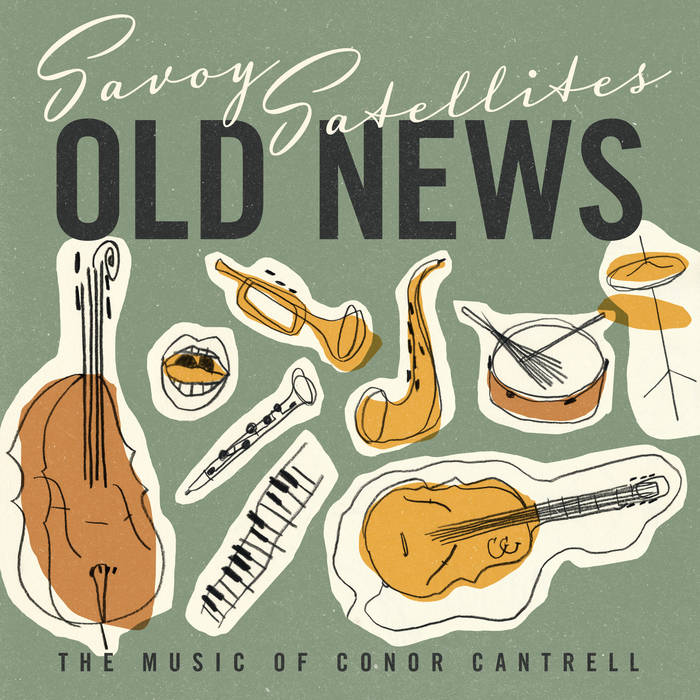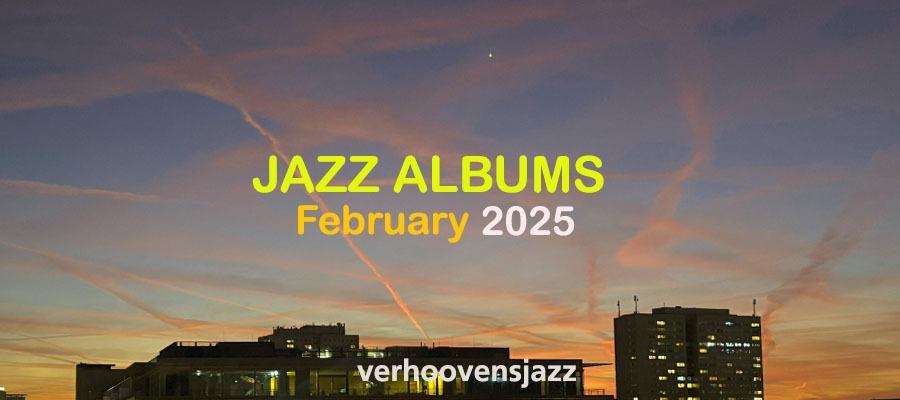
Conor Cantrell – A Place Between Homes
release 02.10.2024
Conor Cantrell – guitar, composition
Johannes Böhmer – trumpet
Riley Stone-Lonergan – saxophone
Will Pethick – trombone
Kenneth Berkel – piano
Max Leiß – bass
David Guy – drums
conorcantrellmusic.com
Am Rande der Wahrnehmung ist nicht im Fokus der Wahrnehmung und wenn etwas überrascht, so immer wieder, wer wo alles als Sideman, als Komponist oder als Arrangeuer in Erscheinung tritt. Wir haben in Berlin jenseits der sich selbst zustimmenden Szenen ebenso vieles an Potential, das sich, ginge es nicht immer nur hart aber unfair zu – längst Gehör verschafft haben müsste oder über allem stehen könnte – und winken.
Die Rede ist von einem, der bei den Savoy Sattelites ebenso zuhause ist, wie er mit Leichtigkeit ein ganzes Album komponiert – nun tritt er aus seinem Schatten mit einer eigenen Aufnahme, mit Kenneth Berkel, den er von den Savoy Sattelites her kennt und mit Johannes Böhmer an der Trompete und Max Leiß am Bass, sowie David Guy am Schlagzeug. David Guy kennen wir von der Aufnahme One Endless Night von und mit Anna Margolina. Max Leiß spielte schon viel mit Bela Meinberg und im Ed Krömer Quintett, oder auch mit Mette Nadja Hansen – die Gesangsstimme von Savoy Sattelites. In all diesen Gruppen und Teams ist der Swing vordergründig Leit- oder Tanzbild – in Conor Cantrells Debut in Eigenregie nun geht es um einige Stufen handfester zu, es kommt sein kompositorisches Vermögen zum Tragen
– und auch welch hervorragender Gitarrist er ist.
Er muss jetzt nicht mehr nur wie im Swing mitschrummeln, er darf auch die eigenen Soli pflegen. Und greift dabei aus dem umfänglichen Repertoire seiner technischen Möglichkeiten an der Gitarre beherzt zu.
Es fehlt noch die Bläsersektion um Johannes Böhmer, Riley Stone-Lonergan und Will Pethick. Johannes Böhmer konnten wir erleben montags mit dem Omniversal Orchestra, Riley Stone-Lonergan ist uns bekannt im Zusammenspiel mit dem QOW Trio mit Eddie Myer und Spike Wells auf dem Album The Hold Up. Einzig Will Pethik an der Posaune blieb dem Radar verborgen. Er spielt in The Will Pethick Electro Band auf, heißt es.
Zu ihrem Album One Endless Night schreibt Anna Margolina: Die Musik komponierte Conor Cantrell, der in Berlin auch seinen Neuanfang erlebte. Darin die Botschaft des nach Berlin Gezogenen steckt, aus Irland stammt er, in England studierte er, in Berlin findet er zu seiner Heimat in der Musik, oder anders: nirgendwo anders fühlt er sich so sicher wie in der Musik.
Die offenkundig sichtbare Umtriebigkeit vieler Biografien unserer Zeit, die auch noch rechtfertigen sollen, warum sie wo gelandet sind – die eigene Erfahrung wird zum Lehrmeister für Verortung oder Zuhause – oder eben, wie der Albumtitel es sagt: A Place between Homes – es gibt mehrere Zuhause, aber irgendwo ist auch der Ort, an dem ich mich aufhalte.
Inspiriert durch die Geschichte der Auswanderung von Irland nach Deutschland reihen sich die Titel aneinander – Departing, Searching, Questions, Winding Streets, Unknown, In Between, Another Goodbye, Arrivel und wieder Departing – Abschied nehmen, Ankommen, Suchen, Fragen stellen und wieder die Abreise – das sind keine Plattitüden für eine Umbruchssituation, das sind handfeste Problemstellungen in ebenso notstiftender Zeit – wo leichtfertig politische Antworten gesucht werden auf Fragen der Leute, die noch nie aufbrechen mussten und noch nie die Frage gestellt haben, warum eigentlich sie von Glück reden können, dass ihnen das nie blühte – zu schnell wird geurteilt und in Frage gestellt und damit wieder in die Flucht getrieben.
Das sind gewichtige Themen, sie lassen sich nicht per Reisepassstempel klären – sie bleiben bestehen in dir, neben dir, über dir, umso mehr, als das Wort Gastfreundschaft sich umgekehrt hat in ein begründe du erstmal deine Aufenthaltsgenehmigung – das alles beantwortet Conor Cantrell auf seine musikalische Art, mit durchdachten Kompositionen, mit ausbrechenden Soli, mit zusammenführenden Linien, mit kompakten Akkordfolgen, mit kräftigen Bläsersätzen, mit bildführenden und atmosphärischen Raumklängen, mit Präzision so leichtfüßig wie fingerfertig, das ist mehr als nur ein Statement for the Artists, das geht rein wie Honig, da wirkt sogar der Abschied wie gezeichnet.
Beispielhaft in Departing, das am Anfang wie am Ende der Aufnahme steht. Fingerleicht und schwebend beinah. Wer kennt das nicht: wenn sich die Türen schließen und das, was man davor oder dahinter erlebt hat, noch nachwirkt. Beispiel Seaching: das Suchen versucht Cantrell gar nicht erst als verzweifeltes Suchen darzustellen, sondern als Standortuntersuchung an Ort und Stelle, die Melodie scheint sich fest zu treten, die Gedanken aber holen die Details heran und leuchten sie aus. Unter verschiedentlicher Darstellung im Wechsel der Bläsersätze zum Klaviersolo, das vom Saxophon abgeholt wird. Auch die Posaune hat dazu einen Satz beizutragen, die Gitarre übernimmt. Sehr fein.
Beispiel Questions: das dürfte eine Akustische sein, die dem Saxophon auf die Sprünge hilft. Die Soli der dann Elektrischen umkreisen den Pool an Fragen und weil nichts beantwortet bleibt, darf das Saxophon zwischenfragen, selbst das Klavier fragt nach – der Schlussakkord wie eine Eröffnung zu den windigen Straßen: Beispiel Winding Streets: das scheint kein stürmischer Wind zu sein in diesen sich windenden Straßen, mehr eine Art Zeichnung eines windigen Zustands, da alles leicht umhertreibt – und sich dreht. Vom Gitarrensolo wieder und wieder aufgewirbelt. Du spürst förmlich jedes fliegende Element zum Greifen nah vorbeikommen. Feines Trompetensolo über weichem Akkordbett, die Gedanken fliegen längst nicht mehr durch windige Straßen, sondern über Herbstlandschaften hinweg, ocker- oder kastanienfarben.
Beispiel : Beat in Unknown. Meine Vermutung geht dahin: du kannst Cantrell irgendetwas deiner Gedankensplitter zurufen, er weiß eine Melodie dazu. Das ist sehr bildhaftes Musizieren, sehr assoziativ und erzählerisch, facetten- und abwechslungsreich dargestellt, knackig.
Beispiel In Between : Appegio hier auf den Gitarrensaiten, Appegio dort im dumpfen Bereich der Pianosaiten, die Bläser etwas unstimmig über den Fortgang der Erzählung, scheinen sich sogar zu bedrängen, so fühlt sich das nämlich an, ständig in between von etwas zu sein, da muss auch mal Luft abgelassen werden.
Solange das Grundrauschen stabil bleibt.
Beispiel Another Goodbye: selbstredend winken alle kreuz und quer so, dass niemand weiß, wer wem winkt, die Kapelle dem Flugzeug oder die Flugzeuginsassen der Kapelle. CU, wir sehen uns, und erklären es uns später, guten Flug auch! Beispiel Arrival: überhöhtes Tor für die Großen, kleine Tür für die Kurzen, überall Girlanden und Blumengesticktes, was hast du uns Schönes mitgebracht? Harmonisches hab ich mir gewünscht, Harmonie habe ich mitgebracht. Ins Wonderland.
Und nochmal der Abflug Departing – alles nochmal von vorn und wieder – wer sich bewegt, kommt mehrfach an – so einfach wie bestechend, ich bleib dabei: gib ihm ein Stichwort, Conor Cantrell hat eine Melodie dazu. Gleich auch : sein Ensemble dankt es ihm mit stimmigen und attraktiven Wortwechseln – cum ergo: eine feinsinnig ausgetüftelte Aufnahme, die weniger störanfällig erscheint als vielmehr beindruckt, wie Kommen und Gehen die Never-Ending-Story ist derjenigen, die sich jeden Tag wo anders die Türklinke in die Hand geben.

by Conor Cantrell
On the fringes of perception is not the focus of perception and if something surprises, it is always who appears where as a sideman, composer or arranger. In Berlin, beyond the self-agreeing scenes, we have just as much potential that, if it weren’t always hard but unfair, would have long since made itself heard or could stand above it all – and waving.
We are talking about someone who is just as much at home with the Savoy Sattelites as he is composing an entire album with ease – now he is stepping out of his shadow with his own recording, with Kenneth Berkel, whom he knows from the Savoy Sattelites, and with Johannes Böhmer on trumpet and Max Leiß on bass, as well as David Guy on drums. We know David Guy from the recording One Endless Night by and with Anna Margolina. Max Leiß has played a lot with Bela Meinberg and in the Ed Krömer Quintet, as well as with Mette Nadja Hansen – the vocalist of Savoy Sattelites. In all these groups and teams, swing is primarily the guiding or dance image – in Conor Cantrell’s debut as an independent artist, things are now a few steps more tangible, his compositional ability comes to the fore
– and also what an outstanding guitarist he is.
He no longer just has to strum along like in swing, he can also take care of his own solos. And in doing so, he makes bold use of his extensive repertoire of technical possibilities on the guitar.
The brass section around Johannes Böhmer, Riley Stone-Lonergan and Will Pethick is still missing. We were able to experience Johannes Böhmer on Mondays with the Omniversal Orchestra, Riley Stone-Lonergan is known to us from his interplay with the QOW Trio with Eddie Myer and Spike Wells on the album The Hold Up. Only Will Pethik on trombone remained hidden from the radar. He plays in The Will Pethick Electro Band, it is said.
Anna Margolina writes about her album One Endless NIght: The music was composed by Conor Cantrell, who also experienced his new beginning in Berlin. It contains the message of the man who moved to Berlin: he comes from Ireland, he studied in England, in Berlin he finds his home in music, or in other words: nowhere else does he feel as safe as in music.
The obviously visible wandering of many biographies of our time, which are also supposed to justify why they have ended up where – one’s own experience becomes a teacher for localization or home – or, as the album title says: A Place between Homes – there are several homes, but somewhere is also the place where I stay.
Inspired by the story of emigration from Ireland to Germany, the titles are strung together – Departing, Searching, Questions, Winding Streets, Unknown, In Between, Another Goodbye, Arrivel and Departing again – saying goodbye, arriving, searching, asking questions and leaving again – these are not platitudes for a situation of upheaval, these are tangible problems in an equally emergency-ridden time – where political answers are sought lightly to questions from people who have never had to leave, who have never asked the question of why they can actually say they are lucky that they have never had to do so.
These are weighty issues, they cannot be resolved with a passport stamp – they remain within you, next to you, above you, all the more so as the word hospitality has turned into a justification for your residence permit – Conor Cantrell answers all of this in his own musical way, with thoughtful compositions, with erupting solos, with unifying lines, with compact chord sequences, with powerful brass sections, with visually guiding and atmospheric spatial sounds, with precision as light-footed as it is dexterous, this is more than just a statement for the artists, it goes down like honey, even the farewell seems to be drawn.
Exemplary in Departing, which stands at the beginning and end of the recording. Light as a finger and almost floating. Who hasn’t experienced this: when the doors close and what you have experienced before or after still lingers. Take Seaching, for example: Cantrell doesn’t even try to portray the search as a desperate search, but as an investigation of the location on the spot, the melody seems to take hold, but the thoughts bring out the details and illuminate them. The wind sections alternate with the piano solo, which is picked up by the saxophone. The trombone also has a movement to contribute, the guitar takes over. Very fine.
Example Questions: this is probably an acoustic that helps the saxophone along. The solos of the then electric instruments circle around the pool of questions and because nothing remains answered, the saxophone is allowed to ask questions in between, even the piano asks questions – the final chord like an opening to the windy streets: Winding Streets example: that doesn’t seem to be a stormy wind in these winding streets, more a kind of drawing of a windy state, as everything drifts slightly – and turns. Whirled up again and again by the guitar solo. You can literally feel every flying element coming close enough to touch. A fine trumpet solo over a soft bed of chords, thoughts no longer fly through windy streets, but over autumn landscapes in ochre or chestnut colors.
Example: Beat in Unknown. My guess is: you can shout something of your thoughts to Cantrell, he knows a melody to it. This is very visual music-making, very associative and narrative, multifaceted and varied, crisp.
Take In Between, for example: Appegio here on the guitar strings, Appegio there in the muffled range of the piano strings, the wind instruments somewhat discordant about the progress of the narrative, even seeming to press against each other, because that’s what it feels like to be constantly in between something, you have to let the air out sometimes.
As long as the background noise remains stable.
Take Another Goodbye, for example: of course, everyone is waving back and forth so that no one knows who is waving to whom, the band to the plane or the passengers to the band. CU, see you and explain later, have a good flight too! Example Arrival: raised gate for the tall ones, small door for the short ones, garlands and embroidered flowers everywhere, what have you brought us? I wished for harmony, I brought harmony with me. To Wonderland.
And again the departure Departing – everything again from the beginning and again – whoever moves, arrives several times – as simple as it is captivating, I stick to it: give him a cue, Conor Cantrell has a melody for it. His ensemble thanks him with coherent and attractive exchanges of words – cum ergo: a finely crafted recording that seems less susceptible to interference than it does to impressing how comings and goings are the never-ending story of those who every day turn the door handle somewhere else.
References











